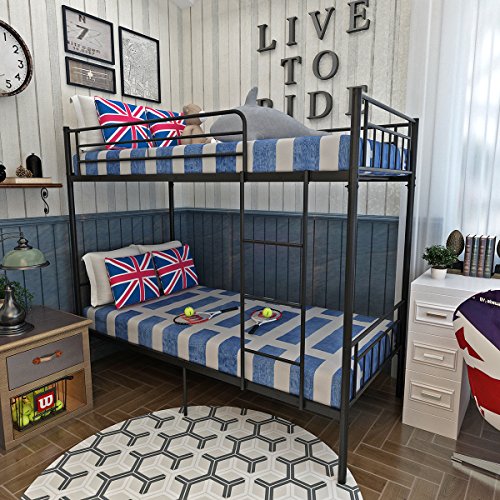Choosing a Bunk Bed For Kids
A bunk bed for kids can provide closeness between siblings and the feeling of sharing an adventure. It can also be able to accommodate twin or full-sized mattresses on the bottom to accommodate sleepovers.
However, before you purchase bunk beds for your kids, take note of these important safety guidelines. Make sure that the ladder and stairs are securely attached to the frame and that the rails that guard your children’s beds do not have enough gaps to cause strangulation.

Safety
Bunk beds are a great space-saving option for children however, they can also be dangerous if they are not properly set up and properly monitored. Always select a bed that has full-length guardrails both on the top and bottom bunk. Also, search for beds that have been tested by a third-party lab for safety and meets all CPSC regulations. If you can, put the bunk bed in a space that has no doors or windows that can open to prevent children from escaping the bunks at nighttime.
When you are choosing a bunk bed, take into consideration the weight capacity and the age of your children. Some bunk beds are only for children, whereas others can be used by adults and teens. Also, consider if you would like the flexibility of an trundle bed on the bottom or if you’d prefer to have a single twin mattress for both beds. If you intend to use the bed for more than two children, make sure the beds are compatible and that there is enough room in the space to accommodate both beds.
Some children are better for the top bunk than others, and it’s essential to assess their readiness for bunk beds on a regular basis. Experts generally recommend that children less than six years old should not sleep on the top bunk because they may not have the coordination and spatial awareness required to safely climb the ladder and reach the height of the upper bed.
If your children frequently have guests staying over, make sure they understand the bunk bed rules concerning the ladder, and that they are not allowed to engage in rough play or hanging from the guardrails. Make sure your children avoid wearing belts, jewelry, and jump ropes out of the bunk bed. These items can be strangulation dangers. Some bunk beds are equipped with stairs instead of ladders, which can provide peace of mind for children who aren’t able to climb. Night lights can be installed on bunk beds for kids to help them safely navigate to and from the top bunk during the night.
Space-Saving
Bunk beds make the most of a small floor space by elevating sleeping areas to open more space for play and studying. This isn’t just ideal for children’s bedrooms, but can also be used to create a focal point for the dining or living room area.
When choosing the best bunk bed for your kids take into consideration the dimensions of your space and their age. At around six or eight, children begin to show the maturity and dexterity that is required for this arrangement. You are the only person who knows your child best and should be able to assess their level of readiness and ensure they’re comfortable and confident of the transition.
A lot of bunk beds come with stairs or ladders to provide easy access to the top level. They take up more floor space than ladder options, but they can be safer for children as they learn to navigate the high of the beds. Some bunks even come with a slide, which gives children a thrilling experience every time they go to bed.
Pick a bunk with ample storage space, especially if you want to choose one with stairs. This design from Lucy Harris Studio includes a built-in drawer beneath the stairs that helps keep the bunks clean and well-organized.
Incorporate a theme in the design of your bunk beds to make them feel more special. A sports-themed bunk is a great choice for kids who love football or baseball. A fairytale-themed bunk would be perfect for little girls. Bunks that include a desk are a great choice for kids who have to complete their homework or work in the evenings.
Bunks are a great choice for siblings who like spending time together but also appreciate the privacy and independence of their own bedrooms. When it is time for sleepovers with siblings, bunk beds allow them to host their friends comfortably without the need of the floor or sofa. In addition, only kids who share rooms with siblings will appreciate the option of having friends over for sleepovers as well.
Convenience
Bunk beds allow siblings to share a room without occupying valuable space. This lets children learn, play and learn together while still enjoying their own space. It can also make it easier for parents to manage a hectic family schedule and keep the house clean. Bunk beds have many features that maximize the use of vertical space that is not being used and integrate well with any style of bedroom.
Selecting a bunk bed to your kids isn’t just about saving you floor space, it can also make a statement about your parenting style. Loft and bunk beds are available in a variety of sizes and styles that will suit any room. Some models include built-in storage while others offer extra storage space with the option of a full or twin trundle. These beds can also be repurposed later in life as your kids grow out of them, since they can easily be converted into two separate single beds or even a daybed.
In addition to saving space, lofts and bunks can bring a sense of excitement and fun to any bedroom. Many children love the chance to claim the top bunk and turn it into a clubhouse, a fort, or even a pirate ship. They can also invite their friends over for sleepovers, and create a space in which they can play with their imaginations.
Spending more time with their siblings during the night can also help them form stronger bonds. No matter how old they are, having each other to talk to through the tough times of siblinghood can help strengthen bonds and foster emotional growth. Loft and bunk beds can be especially useful in accommodating older children with younger siblings, as it gives the older one the opportunity to coach the tween or teen and build a strong bond with them.
The best bunk bed for your child depends on the child’s ability and safety to climb up and down. The average child will be ready for the top bunk by the age of six, but it’s important to determine your child’s mental and physical development. Physical development involves dexterity, coordination and ability to climb ladders. The development of the mind is based on maturity and level.
Style
Bunk beds for children can add a fun, playful look to any bedroom. They are perfect for friends or siblings who share a bed together. They also give children the chance to show their own personality and style by the themes, colors and decor they pick for their room. There are a variety of options to think about when choosing a bunk bed for your child that include:
The most basic design is a bunk bed. It’s two twin-sized bunk beds stacked on top of each other. This arrangement is ideal for siblings who share a room and allows them to easily see each other even when they’re on separate floors. A lot of the standard models of bunk beds offer the option of customization, making it easy to find a bed that will fit any child’s bedroom.
Some bunk beds have special features to make them more attractive and practical. For instance, some are equipped with storage drawers under the bed to keep the space beneath the bunks clean and well-organized. This makes it easy to store bedding, clothes and other things. It is also possible to add curtains or drapes to the bunk beds in order to provide some privacy for sleepers.
Other kinds of bunk beds for children include loft beds that elevate the mattress just a few feet off the ground. This configuration is great for saving space and providing an area to relax, read or study. You can also increase the storage space by adding shelves or a desk.
The final option is to pick the theme of your bunk bed so that it fits seamlessly into the overall theme of the room. Bunk beds can be made in the form of castles, trees, or pirate ships. This will add fun to any bedroom for children. These themed bunks can encourage imagination and encourage creative play.
It’s important to consider your child’s maturity and age when deciding whether bunk beds are the right choice for them. Although the age of six or seven is often considered the ideal time to move to the top bunk, it’s up to you to assess how ready your child is and whether or not they are at ease sleeping on furniture with an elevated position.
Business Hours
| Open | Close | ||
|---|---|---|---|
| Monday | Open (24 Hours) | ||
| Tuesday | Open (24 Hours) | ||
| Wednesday | Open (24 Hours) | ||
| Thursday | Open (24 Hours) | ||
| Friday | Open (24 Hours) | ||
| Saturday | Open (24 Hours) | ||
| Sunday | Open Today (24 Hours) | ||


Leave feedback about this